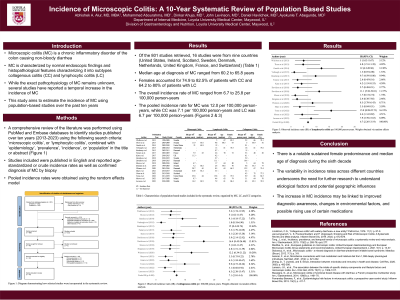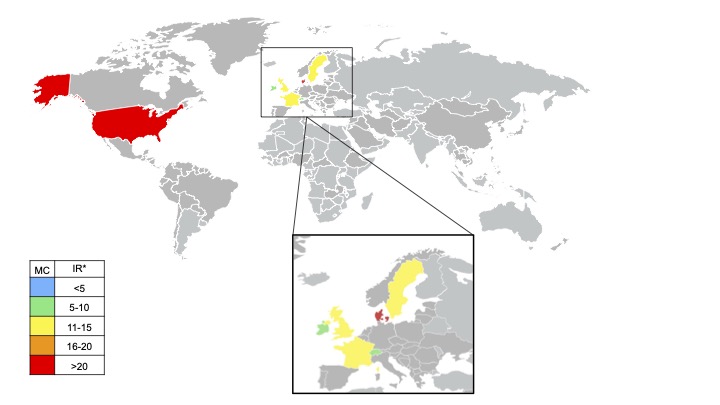Tuesday Poster Session
Category: Colon
P3668 - Incidence of Microscopic Colitis: A 10-Year Systematic Review of Population-Based Studies
Tuesday, October 29, 2024
10:30 AM - 4:00 PM ET
Location: Exhibit Hall E

Has Audio
- AA
Abhishek A. Alur, MD, MBA
Loyola University Medical Center
Chicago, IL
Presenting Author(s)
Abhishek A. Alur, MD, MBA1, Mohammed Abourahma, MD2, Dinkar Ahuja, MD2, John Levinson, MD1, Daniel Havlichek, MD2, Ayokunle T. Abegunde, MD, MSc, MRCP, FACG2
1Loyola University Medical Center, Chicago, IL; 2Loyola University Medical Center, Maywood, IL
Introduction: Microscopic colitis (MC) is a chronic inflammatory disorder of the colon causing nonbloody diarrhea, often in the elderly. It is characterized by normal endoscopic findings and distinct histopathological features, usually divided into collagenous colitis (CC) and lymphocytic colitis (LC) based on the presence or absence of a thickened subepithelial collagen band or intraepithelial lymphocytosis. While the exact pathophysiology of MC remains unknown, several studies have reported a temporal increase in the incidence of MC. This study aims to estimate the incidence of MC using population-based studies over the past ten years.
Methods: We performed a comprehensive review of the literature using the PubMed and Embase databases to identify studies published over ten years (2013-2023) using the following search criteria: ‘microscopic colitis’, 'collagenous colitis’, or ‘lymphocytic colitis’ combined with 'epidemiology', 'prevalence', 'incidence', or 'population' in the title or abstract. We included studies published in English that reported age-standardized and crude incidence rates and confirmed the diagnosis of MC by histology. Abstracts and studies not reporting incidence rates were excluded. In addition, cited references of original studies were manually reviewed to find studies not identified by the searches. Pooled incidence rates were calculated using the random effects model.
Results: Of the 801 studies retrieved, 16 studies from nine countries (United States, Ireland, Scotland, Sweden, Denmark, Netherlands, United Kingdom, France, and Switzerland) were included (Figure 1). The median age at diagnosis of MC ranged from 60.2 to 65.8 years, while the median age at diagnosis of CC was 48 to 72 years and LC was 62 to 70 years (Table 1). Females accounted for 74.9 to 82.5% of patients with CC and 64.2 to 80% of patients with LC. The overall incidence rate of MC ranged from 6.7 to 25.8 per 100,000 person-years, with the lowest rates in Ireland (6.8) and highest (25.8) in the United States. Using the random effects model, the pooled incidence rate for MC was 12.0 per 100,000 person-years, while CC was 7.1 per 100,000 person-years and LC was 6.7 per 100,000 person-years.
Discussion: Microscopic colitis represents an evolving disease, and a comprehensive understanding of its epidemiology is crucial for improving diagnosis and management. This systematic review highlights the increasing incidence of microscopic colitis, sustained female predominance, and an aging cohort of MC patients.

Note: The table for this abstract can be viewed in the ePoster Gallery section of the ACG 2024 ePoster Site or in The American Journal of Gastroenterology's abstract supplement issue, both of which will be available starting October 27, 2024.
Disclosures:
Abhishek A. Alur, MD, MBA1, Mohammed Abourahma, MD2, Dinkar Ahuja, MD2, John Levinson, MD1, Daniel Havlichek, MD2, Ayokunle T. Abegunde, MD, MSc, MRCP, FACG2. P3668 - Incidence of Microscopic Colitis: A 10-Year Systematic Review of Population-Based Studies, ACG 2024 Annual Scientific Meeting Abstracts. Philadelphia, PA: American College of Gastroenterology.
1Loyola University Medical Center, Chicago, IL; 2Loyola University Medical Center, Maywood, IL
Introduction: Microscopic colitis (MC) is a chronic inflammatory disorder of the colon causing nonbloody diarrhea, often in the elderly. It is characterized by normal endoscopic findings and distinct histopathological features, usually divided into collagenous colitis (CC) and lymphocytic colitis (LC) based on the presence or absence of a thickened subepithelial collagen band or intraepithelial lymphocytosis. While the exact pathophysiology of MC remains unknown, several studies have reported a temporal increase in the incidence of MC. This study aims to estimate the incidence of MC using population-based studies over the past ten years.
Methods: We performed a comprehensive review of the literature using the PubMed and Embase databases to identify studies published over ten years (2013-2023) using the following search criteria: ‘microscopic colitis’, 'collagenous colitis’, or ‘lymphocytic colitis’ combined with 'epidemiology', 'prevalence', 'incidence', or 'population' in the title or abstract. We included studies published in English that reported age-standardized and crude incidence rates and confirmed the diagnosis of MC by histology. Abstracts and studies not reporting incidence rates were excluded. In addition, cited references of original studies were manually reviewed to find studies not identified by the searches. Pooled incidence rates were calculated using the random effects model.
Results: Of the 801 studies retrieved, 16 studies from nine countries (United States, Ireland, Scotland, Sweden, Denmark, Netherlands, United Kingdom, France, and Switzerland) were included (Figure 1). The median age at diagnosis of MC ranged from 60.2 to 65.8 years, while the median age at diagnosis of CC was 48 to 72 years and LC was 62 to 70 years (Table 1). Females accounted for 74.9 to 82.5% of patients with CC and 64.2 to 80% of patients with LC. The overall incidence rate of MC ranged from 6.7 to 25.8 per 100,000 person-years, with the lowest rates in Ireland (6.8) and highest (25.8) in the United States. Using the random effects model, the pooled incidence rate for MC was 12.0 per 100,000 person-years, while CC was 7.1 per 100,000 person-years and LC was 6.7 per 100,000 person-years.
Discussion: Microscopic colitis represents an evolving disease, and a comprehensive understanding of its epidemiology is crucial for improving diagnosis and management. This systematic review highlights the increasing incidence of microscopic colitis, sustained female predominance, and an aging cohort of MC patients.

Figure: World map demonstrating updated incidence rates (IR) of microscopic colitis in different geographic areas from the selected studies.
Note: The table for this abstract can be viewed in the ePoster Gallery section of the ACG 2024 ePoster Site or in The American Journal of Gastroenterology's abstract supplement issue, both of which will be available starting October 27, 2024.
Disclosures:
Abhishek Alur indicated no relevant financial relationships.
Mohammed Abourahma indicated no relevant financial relationships.
Dinkar Ahuja indicated no relevant financial relationships.
John Levinson indicated no relevant financial relationships.
Daniel Havlichek indicated no relevant financial relationships.
Ayokunle Abegunde: Ferring Pharmaceuticals – Consultant. Ferring Pharmaceuticals – Consultant.
Abhishek A. Alur, MD, MBA1, Mohammed Abourahma, MD2, Dinkar Ahuja, MD2, John Levinson, MD1, Daniel Havlichek, MD2, Ayokunle T. Abegunde, MD, MSc, MRCP, FACG2. P3668 - Incidence of Microscopic Colitis: A 10-Year Systematic Review of Population-Based Studies, ACG 2024 Annual Scientific Meeting Abstracts. Philadelphia, PA: American College of Gastroenterology.
